Related Research Articles

Edward IV was King of England from 4 March 1461 to 3 October 1470, then again from 11 April 1471 until his death in 1483. He was a central figure in the Wars of the Roses, a series of civil wars in England fought between the Yorkist and Lancastrian factions between 1455 and 1487.

Margaret of Anjou was Queen of England by marriage to King Henry VI from 1445 to 1461 and again from 1470 to 1471. Through marriage, she was also nominally Queen of France from 1445 to 1453. Born in the Duchy of Lorraine into the House of Valois-Anjou, Margaret was the second eldest daughter of René of Anjou King of Naples, and Isabella, Duchess of Lorraine.

Elizabeth Woodville, later known as Dame Elizabeth Grey, was Queen of England from 1 May 1464 until 3 October 1470 and from 11 April 1471 until 9 April 1483 as the wife of King Edward IV. She was a key figure in the Wars of the Roses, a dynastic civil war between the Lancastrian and the Yorkist factions between 1455 and 1487.

Richard Neville, 16th Earl of Warwick, 6th Earl of Salisbury, known as Warwick the Kingmaker, was an English nobleman, administrator, landowner of the House of Neville fortune and military commander. The eldest son of Richard Neville, 5th Earl of Salisbury, he became Earl of Warwick through marriage, and was the wealthiest and most powerful English peer of his age, with political connections that went beyond the country's borders. One of the leaders in the Wars of the Roses, originally on the Yorkist side but later switching to the Lancastrian side, he was instrumental in the deposition of two kings, which led to his epithet of "Kingmaker".
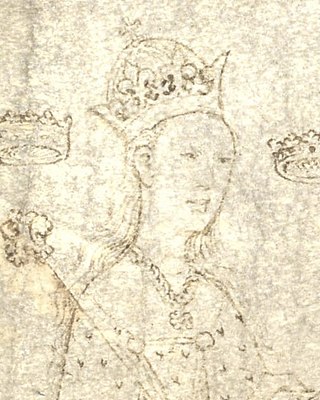
Anne Neville was Queen of England from 26 June 1483 until her death in 1485 as the wife of King Richard III. She was the younger of the two daughters and co-heiresses of Richard Neville, 16th Earl of Warwick, and Anne de Beauchamp. Before her marriage to Richard, she had been Princess of Wales as the wife of Edward of Westminster, Prince of Wales, the only son and heir apparent of King Henry VI.
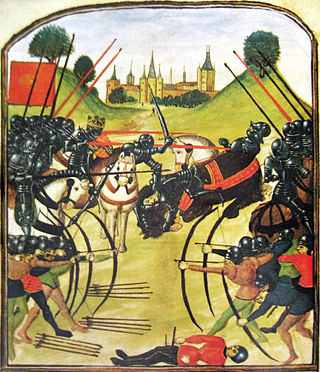
The Battle of Tewkesbury, which took place on Saturday 4 May 1471, was one of the most decisive battles of the Wars of the Roses in England.
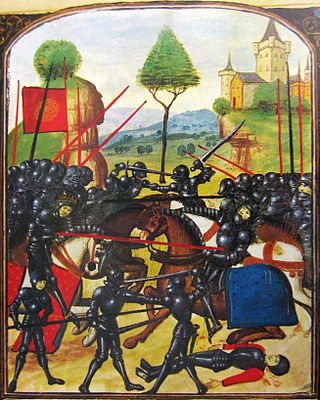
The Battle of Barnet was a decisive engagement in the Wars of the Roses, a dynastic conflict of 15th-century England. The military action, along with the subsequent Battle of Tewkesbury, secured the throne for Edward IV.

Cecily Neville was an English noblewoman, the wife of Richard, Duke of York (1411–1460), and the mother of two kings of England—Edward IV and Richard III. Cecily Neville was known as "the Rose of Raby", because she was born at Raby Castle in Durham, and "Proud Cis", because of her pride and a temper that went with it, although she was also known for her piety. She herself signed her name "Cecylle".
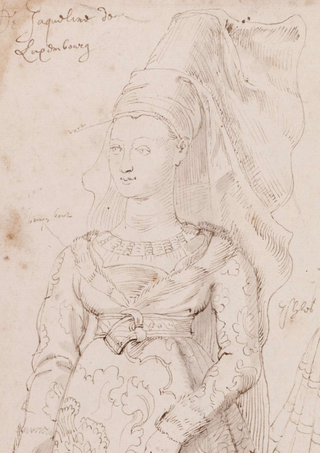
Jacquetta of Luxembourg was a prominent figure in the Wars of the Roses. Through her short-lived first marriage to the Duke of Bedford, brother of King Henry V, she was firmly allied to the House of Lancaster. However, following the emphatic Lancastrian defeat at the Battle of Towton, she and her second husband Richard Woodville sided closely with the House of York. Three years after the battle and the accession of Edward IV of England, Jacquetta's eldest daughter Elizabeth Woodville married him and became queen consort of England. Jacquetta bore Woodville 14 children and stood trial on charges of witchcraft, of which she was exonerated.
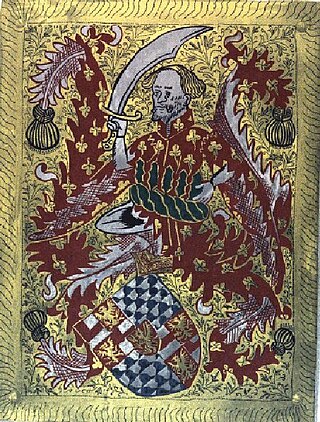
Richard Woodville, 1st Earl Rivers, also Wydeville, was the father of Elizabeth Woodville and father-in-law of Edward IV.

John de la Pole, Earl of Lincoln was a leading figure in the Yorkist aristocracy during the Wars of the Roses.
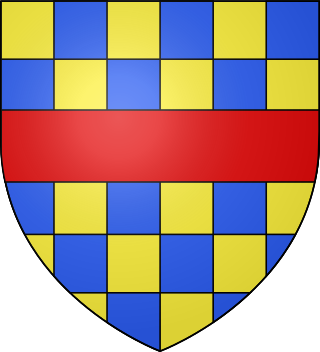
John Clifford, 9th Baron Clifford, 9th Lord of Skipton was a Lancastrian military leader during the Wars of the Roses in England. The Clifford family was one of the most prominent families among the northern English nobility of the fifteenth century, and by the marriages of his sisters, John Clifford had links to some very important families of the time, including the earls of Devon. He was orphaned at twenty years of age when his father was slain by partisans of the House of York at the first battle of the Wars of the Roses, the Battle of St Albans in 1455. It was probably as a result of his father's death there that Clifford became one of the strongest supporters of Margaret of Anjou, wife of King Henry VI, who ended up as effective leader of the Lancastrian faction.

Anne of York, Duchess of Exeter, aka Anne Plantagenet, was the first child of Richard Plantagenet, 3rd Duke of York, and Cecily Neville. She was thus the eldest sister of kings Edward IV (1461–1483) and Richard III (1483–1485) and their siblings Edmund, Earl of Rutland; Elizabeth of York, Duchess of Suffolk; Margaret, Duchess of Burgundy; and George Plantagenet, 1st Duke of Clarence.
Anne Woodville, Viscountess Bourchier was an English noblewoman. She was a younger sister of Queen Consort Elizabeth Woodville to whom she served as a lady-in-waiting. Anne was married twice; first to William Bourchier, Viscount Bourchier, and secondly to George Grey, 2nd Earl of Kent. Anne was the grandmother of the disinherited adulteress Anne Bourchier, 7th Baroness Bourchier, and an ancestress of Robert Devereux, 2nd Earl of Essex.
Katherine Neville, Baroness Hastings, was a noblewoman and a member of the powerful Neville family of northern England. She was one of the six daughters of Richard Neville, 5th Earl of Salisbury, and the sister of military commander Richard Neville, 16th Earl of Warwick, known to history as Warwick the Kingmaker.
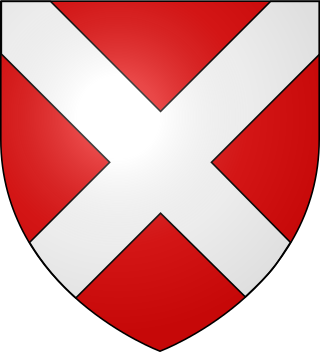
The House of Neville or Nevill family is a noble house of early medieval origin, which was a leading force in English politics in the Late Middle Ages. The family became one of the two major powers in northern England and played a central role in the Wars of the Roses along with their rival, the House of Percy.

The Readeption was the restoration of Henry VI of England to the throne of England in 1470. Edward, Duke of York, had taken the throne as Edward IV in 1461. Henry had fled with some Lancastrian supporters and spent much of the next few years in hiding in Northern England or in Scotland, where there was still some Lancastrian support. Henry was captured in 1465 and was held as a prisoner in the Tower of London. Following dissent with his former key supporter, Richard Neville, 16th Earl of Warwick, Edward was forced to flee in 1470. Henry was then restored to the throne, although he was deposed again the following year.

The Wars of the Roses, known at the time and in following centuries as the Civil Wars, were a series of civil wars fought over control of the English throne from 1455 to 1487. The wars were fought between supporters of the House of Lancaster and House of York, two rival cadet branches of the royal House of Plantagenet. The conflict resulted in the end of Lancaster's male line in 1471, leaving the Tudor family to inherit their claim to the throne through the female line. Conflict was largely brought to an end upon the union of the two houses through marriage, creating the Tudor dynasty that would subsequently rule England.

The Second Battle of St Albans was fought on 17 February 1461 during the Wars of the Roses in St Albans, Hertfordshire, England.

The siege of London was an episode of the Wars of the Roses between 12 and 15 May 1471, in which adherents of the House of Lancaster commanded by Thomas Neville unsuccessfully attempted to storm the city and free King Henry VI, who had been imprisoned in the Tower of London by his rival Edward IV of the House of York. This confrontation, which was an epilogue to the recent battles of Barnet and Tewkesbury, completed the final restoration of Edward IV and ensured the Yorkist hold on the throne.
References
- 1 2 3 4 5 6 7 8 9 10 11 12 13 14 15 16 17 18 19 20 21 22 Palmer, Alan; Palmer, Veronica (1992). The Chronology of British History. London: Century Ltd. pp. 128–131. ISBN 0-7126-5616-2.
- 1 2 Bennett, Vanora. "London and the Wars of the Roses". Archived from the original on 2013-09-14. Retrieved 2013-08-16.
- 1 2 3 4 Williams, Hywel (2005). Cassell's Chronology of World History . London: Weidenfeld & Nicolson. pp. 183–185. ISBN 0-304-35730-8.
- 1 2 Penguin Pocket On This Day. Penguin Reference Library. 2006. p. 90. ISBN 0-14-102715-0.
- ↑ Dunn, Diana E. S. (2004). "Margaret (1430–1482)". Oxford Dictionary of National Biography . Oxford University Press. doi:10.1093/ref:odnb/18049 . Retrieved 2016-03-16.(subscription or UK public library membership required)
- ↑ Abram, William Alexander (1877). Parish of Blackburn, County of Lancaster: A History of Blackburn, Town and Parish. Blackburn: J. G. & J. Toulmin. p. 57 . Retrieved 2024-07-20.
- ↑ Jones, Dan (2014). The Hollow Crown: The Wars of the Roses and the Rise of the Tudors. London: Faber. p. 195. ISBN 978-0-5712-8809-0.
- ↑ Weir, Alison (2011). The Wars of the Roses. Random House. p. 333. ISBN 978-0-3078-0685-7.
- 1 2 3 Tucker, Penny (2021). "'Robin of Resesdale's Rebellion' of 1469". Northern History . 58: 239–58.